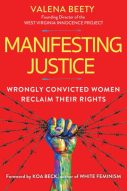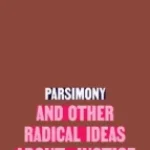Manifesting Justice: Wrongly Convicted Women Reclaim Their Rights

Author: Valena Beety
Publisher: Kensington Publishing Corp., 2022. 320 pages.
Reviewer: Elizabeth Webster | January 2024
A New Direction for the Innocence Movement
In the world of criminal justice reform, the “innocence movement”[1] has had an immeasurable impact. By demonstrating the actual innocence and prolonged wrongful incarceration of thousands of people from hundreds of jurisdictions across the country,[2] it has demonstrated that wrongful convictions can no longer be dismissed as “an unreal dream.”[3] It recognizes errors of justice as evidence of the need for reform in many areas, including interrogation practices, eyewitness identification procedures, and outdated forensic methods. Professor Valena Beety substantially contributed to these efforts through her role as the Founding Director of the West Virginia Innocence Project and as a Senior Staff Attorney at the Mississippi Innocence Project. She has fought prosecutors for the right to postconviction DNA testing, exposed official misconduct, and exonerated wrongfully convicted prisoners. Now, with Manifesting Justice, she calls for a new era of reform that will build upon the innocence movement’s accomplishments and broaden the scope of the impact beyond actual innocence.
Beety reaches several aims in Manifesting Justice. First, she offers “a passport”[4] to the world of innocence litigation through compelling wrongful conviction case examples and extended discussion of system flaws. Second, she initiates a long overdue analysis of how wrongful convictions uniquely impact queer people. Third, she presents a guide for social change and social movement evolution: “a new expanded vision of wrongful convictions.”[5] In so doing, she contributes to a larger, ongoing conversation among criminal justice reform advocates about expanding the innocence movement in a new direction.
Throughout the book, readers follow the wrongful conviction and exoneration of Leigh Stubbs and Tami Vance, whose biased prosecution targeted the defendants as lesbians. Stubbs and Vance were convicted of assaulting their friend, Kim Williams, in what the prosecution characterized as a brutal homosexual rape. At the time of the alleged attack, Williams was suffering from a drug overdose, and Stubbs and Vance had called an ambulance for her. Beety describes the homophobia, prosecutorial misconduct, and egregious forensic fabrications that contributed to their wrongful conviction. The notorious forensic dentist, Dr. Michael West, a feature of multiple Mississippi wrongful convictions cases, played a central role. In the following excerpt, Beety explains how the prosecution in the Stubbs and Vance case employed West as a tool to persuade jurors of their version of events.
Every determination by Dr. West in their case was an essential component of the state’s case. He testified to video evidence of Kim in a toolbox, bite mark evidence of an assault to her hip and vagina, wound expert evidence of marks to Kim’s breasts, and even testified about the role of Narcan and overdoses. Dr. West’s testimony eventually took up nearly 250 transcript pages. But his evidentiary reports to the police were one page each—one page for the video, and one page for the bite marks.[6]
This detailed coverage of the trial and the postconviction proceedings places Manifesting Justice squarely in the genre of defense attorneys’ popular accounts of freeing their innocent clients. Like the best of these books (most notably Just Mercy[7]) readers learn about both systemic injustice and procedural errors.
Beety situates Stubbs and Vance’s wrongful conviction in the larger context of the “criminalization of queerness.”[8] At the trial, jurors heard testimony from a forensic pathologist that homosexual crimes were particularly “sadistic” “violent” “gory” and “repulsive.”[9] Beety’s explicit acknowledgement of how gender bias, homophobia, and transphobia contribute to wrongful convictions takes on special relevance in a post-Roe, don’t-say-gay political climate.
Heretofore, the innocence movement has largely overlooked not only queer people, but women. Beety writes: “Innocence projects represent a shockingly low number of women.”[10] Due to the nature of the alleged crimes, women are rarely candidates for postconviction DNA testing. This is partly due to the high incidence of “no crime” cases among women’s wrongful convictions. According to the National Registry of Exonerations 63% of female exonerees have been wrongfully convicted of crimes that never occurred.[11] Stubbs and Vance’s case is listed among them. In addition, 40% of women exonerees were wrongfully convicted of crimes against children.[12] Such emotionally charged cases can provoke particularly zealous prosecutorial reactions, and they also play into stereotypical attributions about women’s maternal roles.[13] All of these factors make women’s wrongful convictions difficult to overturn.
Although other scholars have begun to explore phenomena unique to women’s wrongful conviction cases, Beety expands the focus in useful ways. By employing the concept of manifest injustice, she considers also those cases involving victims of sex trafficking prosecuted for sex work, pregnant women prosecuted for endangering the health of a fetus, and transgender women targeted for selective prosecution under ambiguous, overly broad laws. This expanded focus allows for a greater recognition of system harms against women beyond the wrongful conviction of the factually innocent. Beety demonstrates how the narrowed interest in actual innocence has neglected important cases of legal innocence. She writes “We can apply the term ‘wrongfully convicted’ to more people, as our society also begins to recognize criminal injustice more broadly. Manifest injustice is a new direction for growth and change as a theory and a reality.”[14]
Throughout the book, Manifesting Justice implicitly calls out to activists, legal practitioners, and lawmakers, to recognize both the theory and the potential reality of Beety’s vision. On the conceptual level, Beety argues that systemic injustices facing women, queer people and people of color, cannot be adequately addressed through innocence work alone. On the practical level, she provides multiple solutions to address both factual and legal errors. Many of these reforms are inspired by actions already taken in some state legislatures, local jurisdictions, and judicial rulings. Two separate chapters propose specific changes to postconviction habeas law including: eliminating the one-year filing deadlines in federal habeas law, encouraging state courts to conduct a confluence-of-factors review, and considering race and gender stereotypes as contributing factors in wrongful convictions. Another chapter proposes reforms to improve the quality of forensic evidence. These include funding forensic experts to offer their opinions on the validity of forensic evidence pre-trial, allowing convicted defendants to petition the court through a “junk science writ,” and releasing forensic findings directly to both defense attorneys and prosecutors. Many of these reforms follow directly from Stubbs and Vance’s wrongful conviction though some look beyond the case to additional injustices that Beety argues should be addressed by the innocence movement of the future. These include proposed solutions in areas such as ending the War on Drugs, expanding clemency and expungement, and implementing prosecutorial reform and restorative justice. All proposals are compiled in an appendix: “Checklist of Tools for Manifesting Justice.”
Clearly, Beety’s scope is broad and ambitious. The book uses the Stubbs and Vance case as an organizational frame, interspersed with relevant commentary, musings, and proposed reforms. Some readers may find these interruptions compromise the fluidity of the narrative. Indeed, the early chapters do require keen attention to the somewhat complicated facts of the case, which is set aside and resumed again from one chapter to the next. Readers who approach the book more as a guide or a reference to read out of order will gain the most from it. The book invites readers to return to it repeatedly. It lends itself well to excerpting for course content or mining for policy recommendations.
In this new era of the innocence movement, Beety stands on the cutting edge of wrongful conviction work, identifying those cases that had largely been overlooked under the existing paradigm. Manifesting Justice will appeal to those new to wrongful conviction scholarship, as well as those leaders and lawyers who have shaped the trajectory of the innocence movement. The book’s greatest accomplishments lie in acknowledging neglected injustices and outlining a more inclusive path forward.
Elizabeth Webster is an Assistant Professor of Criminal Justice at Loyola University Chicago.
[1] For a definition, see, Marvin Zalman, Integrated Justice Model of Wrongful Convictions, 74 Albany Law Rev. 1468 (2010).
[2] The National Registry of Exoneration has identified nearly 3,500 cases of wrongful conviction, as of January 2024. See: https://www.law.umich.edu/special/exoneration/Pages/about.aspx
[3] United States v. Garsson, 291 F. 646, 649 (S.D.N.Y. 1923) (Hand, J.) (“Our procedure has always been haunted by the ghost of the innocent man convicted. It is an unreal dream.”).
[4] Manifesting Justice at 2
[5] Id.
[6] Id. at 122.
[7] Bryan Stevenson, Just Mercy: A Story of Justice and Redemption (Penguin 2014).
[8] Manifesting Justice at 104.
[9] Id. at 147, 148.
[10] Id. at 175
[11] National Registry of Exonerations, see “Female Exonerees: Trends and Patterns” available at: https://www.law.umich.edu/special/exoneration/Pages/Features.Female.Exonerees.aspx
[12] Id.
[13] E. Webster & J. Miller, Gendering and Racing Wrongful Conviction: Intersectionality, Normal Crimes, and Women’s Wrongful Convictions, 78 Albany Law Review 973 (2014).
[14] Manifesting Justice at 6.


